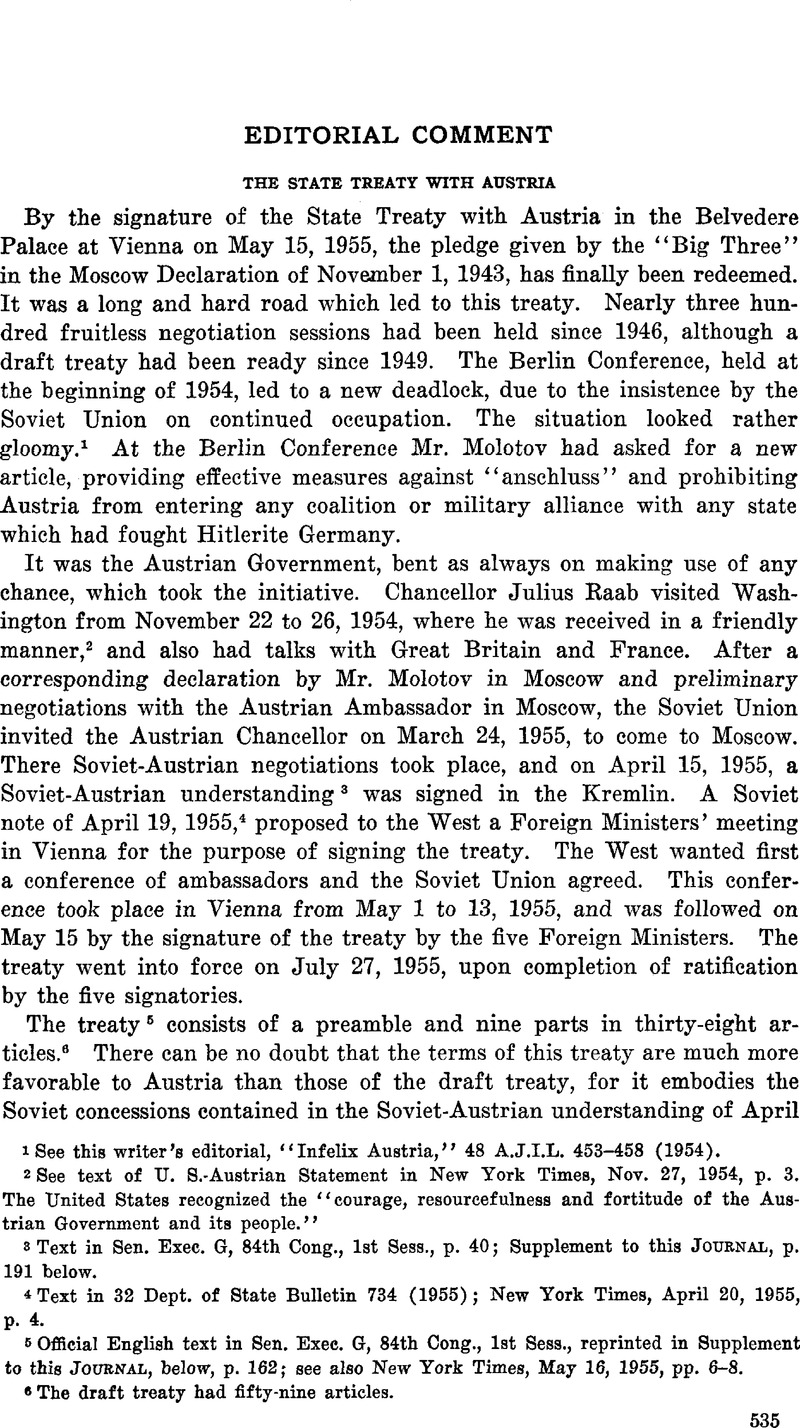No CrossRef data available.
Article contents
The State Treaty With Austria
Published online by Cambridge University Press: 30 March 2017
Abstract

- Type
- Editorial Comment
- Information
- Copyright
- Copyright © American Society of International Law 1955
References
1 See this writer's editorial, “Infelix Austria,” 48 A.J.I.L. 453–458 (1954)Google Scholar.
2 See text of U. S.-Austrian Statement in New York Times, Nov. 27, 1954, p. 3. The United States recognized the “courage, resourcefulness and fortitude of the Austrian Government and its people.”
3 Text in Sen. Exec. G, 84th Cong., 1st Sess., p. 40; Supplement to this Journal, p. 191 below.
4 Text in 32 Kept, of State Bulletin 734 (1955); New York Times, April 20, 1955, p. 4.
5 Official English text in Sen. Exec. G, 84th Cong., 1st Sess., reprinted in Supplement to this Journal, below, p. 162; see also New York Times, May 16, 1955, pp. 6–8.
6 The draft treaty had fifty-nine articles.
7 Now Art. 22 of the treaty.
8 Art. 16 dealt with the “voluntary repatriation of displaced persons within Austrian territory,” an article Which might have endangered many refugees in Austria from behind the Iron Curtain. Text of this article in New York Times, May 4, 1955, p. 12.
9 Original text in New York Times, May 15, 1955, p. 13.
10 Art. 37.
11 Arts. 1 and 2.
12 Art. 5.
13 Arts. 6, 7, 8.
14 Art. 10. The Austrian Chancellor, it was reported, regretted this article as a “superfluous limitation of Austrian sovereignty.”
15 Arts. 13 and 14.
15a Art. 14.
16 Art. 16.
17 Art. 12; it is, in general, an anti-Nazi article.
18 Art. 18.
19 Art. 19.
20 Art. 17.
21 Art. 21.
22 Art. 23.
23 Art. 27.
24 Arts. 23, 24, 25.
25 Art. 26.
26 Art. 29.
27 And not only for all of the United Nations (Art. 31).
28 Austria’s oil production was three million tons in 1954.
29 This latter concession was already made by the Soviet Union at the Berlin Conference in 1954.
30 E.g., those originally belonging to Jewish owners, but where for fifteen years small farmers have been compulsorily settled; or those still belonging to German nationals. A special case is that of the latifundia of Prince Esterházy in the Burgenland which certainly do not constitute “German assets,” but were long ago confiscated by the Soviet Union. Later, Prince Esterházy, a Hungarian citizen, together with Cardinal Mindszenty, was condemned by Communist Hungary and all his property declared confiscated.
31 Art. 25, par. 4a.
32 Marek, Krystyna, Identity and Continuity of States in International Law (Geneva, 1954)Google Scholar.
33 32 Dept. of State Bulletin 873 (1955) ; New York Times, May 16, 1955, p. 6.




